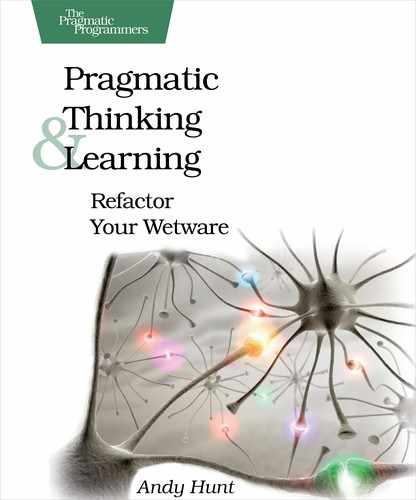Work Together, Study Together
Studies have shown that peer study groups are very much “the real thing.” The topics are chosen by the participants and so are directly relevant to your daily work. Sessions can be arranged to fit in with your schedule flexibly and conveniently; there’s no expensive travel or materials required.[104] A study group is a great alternative to the alien, toxic, sheep dip experience.
Reading groups are nontoxic.
Ever since The Pragmatic Programmer was published, we’ve heard from folks using it for their own, in-company reading and study groups. It’s a great book to get started with, because it’s not tied to any particular technology, language, or methodology. You can start with a general book or pick something very specific and targeted to your team and your project.
You have several choices in setting up a study group, ranging from the informal to the formal. On the informal side, you can just all agree to read through a book. Maybe take turns and have team members sum up chapters on a wiki or on a mailing list or get together for lunch and discuss it.
On the more formal side, you want to take a couple of deliberate steps[105]
- Ask for proposals
-
See what’s on everyone’s mind. Get a pile of proposals, with a champion for each. Ask for a wide variety of topics: some technical and some on soft skills or on technology you’re already using or on technology you hope to use.
- Select a proposal—and a leader
-
You need someone to lead the study group for this particular subject. They don’t have to be expert in the topic but do need to be passionate about the topic and about learning it.
- Buy books
-
The company buys books for all participants. Most publishers (including the Pragmatic Bookshelf) provide volume discounts, so be sure to check.
- Schedule lunch meetings
-
The company provides lunch if they can, or you can brown-bag it. Reading itself should be done on your own time, but schedule the meeting for lunch, and plan on a longish lunch of ninety minutes.
In the meeting itself, plan on spending the first half hour eating, socializing, and in informal conversation. Then, start the meeting proper. Have one person summarize the chapter or sections that everyone read. Rotate through, by topic or by chapter, so it’s not always the same person. Then talk about it: ask questions, give opinions. For inspiration, you can look at questions at the end of chapters, any explicit study guide questions, or the next actions that I’ve provided here.
| Recipe 28 | Form study groups to learn and teach. |
Try to keep each group to no more than eight to ten people or so. If you have larger teams, maybe split them up into smaller groups for discussion.
Beside the incredible education benefits, it’s a great way to help jell a team. The team that studies together learns together, teaches each other, and learns more effectively.
